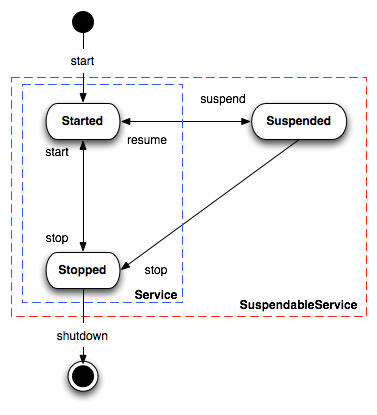Camel Lifecycle
Camel uses a simple lifecycle interface called Service which has a single start() and stop() method.
Various classes implement Service such as CamelContext along with a number of Component and Endpoint classes.
When you use Camel you typically have to start the CamelContext which will start all the various components and endpoints and activate the routing rules until the context is stopped again.
If you are working with Spring you may wish to read the Camel Spring documentation.
CamelContext Lifecycle
The CamelContext provides methods to control its lifecycle:
-
start -
stop -
suspendCamel 2.5 -
resumeCamel 2.5
The operations is paired: start/stop and suspend/resume.
Stop is performing a Graceful shutdown
which means all its internal state, cache, etc is cleared. And the
routes is being stopped in a graceful manner to ensure messages are given
time to complete. If you start a CamelContext after a stop, then its
performing a cold start, recreating all the state, cache etc. again.
Instead you can use the suspend/resume operations. They will keep the
CamelContext warm and only suspend/stop routes using the same
Graceful shutdown feature. This ensures messages are given time to complete.
End users is encouraged to use suspend/resume if you are temporary stopping a Camel application.
All these operations are available in JMX as well, so you can control Camel from a management console.
If you write unit tests and perform cold restarts using stop/start then any previously looked up Endpoints etc. is obsolete, and therefore you need to re-lookup those endpoints again.
Instead use suspend/resume which keeps these Endpoints and therefore you can still use them after resuming.
Service lifecycle
A service (org.apache.camel.Service) in Camel adheres to the following
lifecycle states as illustrated in the diagram below:

Notice: A service can optimally support suspend/resume by the
org.apache.camel.SuspendableService. This means not all services in
Camel supports suspension. It’s encouraged that consumers support
suspension which allows to suspend/resume routes.
The org.apache.camel.support.service.ServiceSupport is a good base class to
extend for custom services as it offers the basic functionally to keep
track of state. You implement your custom logic in the doStart,
doStop, doSuspend, doResume methods.
Routes lifecycle
Routes in Camel have the following operations to control its lifecycle
-
start -
stop -
suspend -
resume -
remove(previously named shutdown)
The remove operation will remove the route, for example in
JMX the route will then be unregistered and its
gone. So only use remove if you really want to remove the route. The
route must have been stopped before you can remove.
The start and resume operations in JMX checks
the state beforehand. So if a route is stopped and you click resume,
it will know to invoke start. And likewise if a route has been
suspended and you click start it knows to resume instead. This makes
management a bit easier.
If a route is suspended then it keeps its resources and all their JMX metrics alive. Where as stopping a route will graceful stop the route, and clear its resources, and as well their JMX metrics. If you want to temporary "pause" a route, then consider using suspend/resume over stop/start.
If a route consumer does not support suspension, it will fallback and stop the route instead.